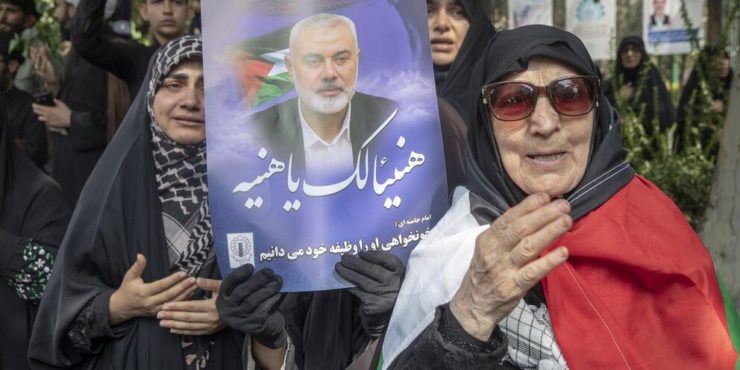
Following the assassinations of Hamas political leader Ismail Haniye in Tehran and Hezbollah military leader F. Shukr, dark clouds stretch across the political horizon of the Middle East. If denoted, the amount of built-up tension will lead to the ignition of an armed fire in the region. It is clear that there is a chain reaction of threats, amplifying the mutual irreconcilability.
The revenge for I. Haniye’s assassination will be severe
Iranian Supreme leader Khamenei promised Israel ‘severe punishment’ for Haniyeh’s blood. According to Hezbollah Secretary General H. Nasrallah, the military objects of the enemy in the north worth billions of dollars can be destroyed ‘in one, or even in half an hour’. The head of the Israeli General Staff, Herzi Halevi, did not hesitate and declared his readiness to undertake a quick raid on any place in Lebanon, Gaza and the Middle East ‘above or below ground’. The media in the Middle East is full of comments and gloomy fear-mongering scenarios. There is talk of a turning point in the confrontation between Israel and the so-called ‘Axis of Resistance’ on various fronts. The majority of supporters of this thinking hold the opinion that Israel and its Prime Minister, Netanyahu, who gave the green light to these attacks, are responsible for the situation in the region. He was well aware that this would lead to an escalation of the conflict. Many agree that the death of I. Haniyeh will hinder achieving a ceasefire agreement in the Gaza Strip and the release of detained Israelis. The 62-year-old Hamas veteran was a key figure in the negotiations mediated by Egypt and Qatar. Therefore, his elimination will delay them for several months, although Hamas is used to replacing and promoting new leaders.
Smouldering tension
In the tactics of Israel’s ‘surgical operations’, Arab analysts see a desire to strike at the prestige of the leadership of Iran and its allies, humiliate and provoke a chaotic emotional reaction under the influence of emotions.
Commentators are actively debating the topic of the countries and organisations that have become Israeli targets choosing the right moment to respond to Israel.
The Lebanese Centre for Consultations and Research refers to sources in Hezbollah, who reported that the organisation is in no hurry to launch attacks on Israel, but they ‘will certainly take place’. At the same time, Hezbollah is keeping Israel on its toes by using the ‘Sword of Damocles’ tactic (brandishing an arsenal of available missiles), a manipulation using the surprise factor for a response to take the enemy by surprise and hit his weak spots. Some Palestinian sources are quoted as betting that delaying the response will keep Israel in mobilisation tension, which risks increased costs and the depletion of its resources and potential.
At the moment, according to a number of researchers, if Iran finds the right balance in its response (given the huge price and potential costs for a real answer), then a full-scale war in the region will be avoided.
Then this tension will smoulder and Iran will continue its confrontation with Israel mainly through its allies in the Axis of Resistance, according to Imad Salame, a political scientist at the Lebanese-American University. It is important to demonstrate a broad front against Israel so that the members of the Axis of Resistance can save face without getting involved in a direct clash with Israel and Washington.
In the media discourse, they are calculating possible answers, scrupulously comparing forces, the power of weapons, their stocks and other aspects, as well as drawing analogies.
Political scientists are paying attention to the geographical configuration of the actors involved in a possible confrontation, which can greatly affect military strategic plans and, most importantly, their implementation.
Iran does not share a border with Israel and the distance between Tehran and Tel Aviv is about 1,800 kilometres. The flight tie of Iranian UAVs and missiles may be enough for advanced Israeli air defence to prepare and react.
British and French systems are ready to intervene and NATO is ready to act similarly to the scenario in Ukraine, creating a state of complete chaos and closing airspace in the region, Egyptian newspaper Akhbar Al-Yaum warns.
The actors have differing, asymmetrical territories and populations, as well as natural conditions. The same applies to the different levels of their armaments, manpower and military budgets, etc. All this creates a complex network of strategic (and other) problems and contradictions for the countries involved in the conflict. If it breaks out, the consequences are impossible to predict.
According to the Saudi newspaper Al-Sharq Al-Awsat, it becomes clear from the reactions, whether from Iran or Lebanese Hezbollah, that despite the moral, political and other losses they have suffered, they do not want to be drawn into a confrontation deliberately planned by B. Netanyahu, who is an influential person in Washington.
Yury Zinin, senior researcher at the Centre for Middle Eastern and African Studies of the Moscow State Institute of International Relations (MGIMO) of the Ministry of Foreign Affairs, exclusively for the online magazine «New Eastern Outlook»
